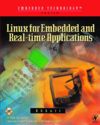New book: “Linux for Embedded and Real-Time Applications”
May 22, 2003 — by LinuxDevices Staff — from the LinuxDevices Archive — 1 views
Newnes Press has announced publication of a new book on the subject of using Linux in embedded and real-time applications. The 250-page book, titled Linux for Embedded and Real-Time Applications (ISBN 0-7506-7546-2) and written by Doug Abbott, covers topics such as device drivers, kernel implementation, and POSIX threads,… with a heavy emphasis on real-time Linux technologies and implementations.
Included inside the back cover of the book is a CDROM that contains an electronic version of the book (with hyperlinked table of contents and index), plus various software tools and code listings. Among other things, the CDROM contains working versions of two embedded Linux distributions — LynuxWorks BlueCat Linux and TimeSys Linux (although the later doesn't appear to be mentioned anywhere in the book) — plus, a copy of the RTAI real-time add-on for Linux.
Here is a brief description of the book provided by the publisher . . .
In this applications-oriented reference, Doug Abbott shows how to put Linux to work in embedded and real-time applications. Among the topics Abbott discusses include memory management, device drivers, interrupt handling, kernel instrumentation, boatloaders, embedded networking, inter-task communications, periodic vs. “one shot” timing, POSIX threads, hardware abstraction layers, and program debugging. Abbott uses numerous real-world examples to show how implement a variety of embedded applications using Linux. Abbott discusses the strengths and weaknesses for embedded applications of different implementations of Linux, and he also examines the different real-time extensions for Linux. This book incorporates many programming exercises with solutions. All code listings are provided on the accompanying CD-ROM, as well as an electronic version of the text.
And from the back cover . . .
In some ways, Linux is the exact antithesis of an embedded/real-time operating system, but it does offer a number of advantages — not the least of which is the fact that it's free and the source code is open and available. Linux is rapidly growing in popularity with embedded programmers and engineers, but information can be tough to locate. This practical hands-on guide by a noted embedded systems programmer and author solves that problem. In these pages, Abbott covers the many issues concerning Linux in the embedded space and provides different approaches to giving the Linux kernel determinstic characteristics.
Here's a list of chapter titles . . .
- Chapter 1: The Embedded and Real-time Space (7 pages)
Chapter 2: Introducing Linux (20 pages)
Chapter 3: The Host Development Environment (15 pages)
Chapter 4: BlueCat Linux (14 pages)
Chapter 5: Debugging Embedded Software (14 pages)
Chapter 6: Kernel Modules and Device Drivers (24 pages)
Chapter 7: Embedded Networking (11 pages)
Chapter 8: Introduction to Real-time Programming (28 pages)
Chapter 9: Linux and Real-time (6 pages)
Chapter 10: The RTAI Environment (18 pages)
Chapter 11: POSIX Threads (28 pages)
Appendix A: RTAI Application Program Interface (32 pages)
Appendix B: Posix Threads (Pthreads) Application Programming Interface (16 pages)
Appendix C: Why Software Should Not Have Owners (8 pages)
About the book's author (from the publisher's website) . . .
Doug Abbott is founder and president of Intellimetrix, Inc., a computer hardware design firm in Silver City, New Mexico. He has conducted seminars on PCI bus theory and design for such companies as Intel and Sun Microsystems.
The book is available for $49.99 (US) from the publisher's website.
This article was originally published on LinuxDevices.com and has been donated to the open source community by QuinStreet Inc. Please visit LinuxToday.com for up-to-date news and articles about Linux and open source.